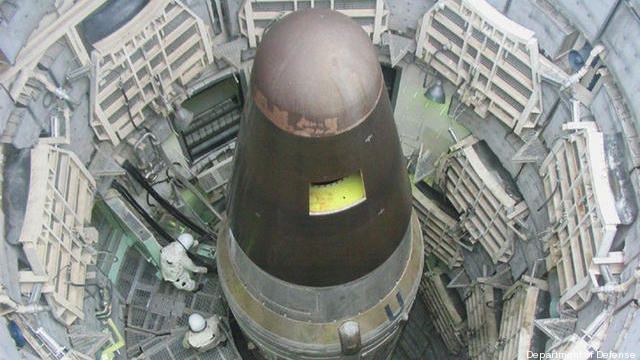
Minuteman III ICBM
CAPITOL HILL: The Pentagon’s official estimate of $85 billion to replace the Minuteman III ICBM — already 37 percent above the Air Force’s $62 billion figure — is itself a low-end estimate, the head of Cost Assessment & Program Evaluation says. CAPE almost never offers alternative estimates of a program’s cost, said director Jamie Morin, but it had to here because there’s so much uncertainty over the Ground-Based Strategic Deterrent, which has not been replaced for 40 years. By contrast, Morin sounded much more confident about the B-21 Raider bomber and the Ohio Replacement Program submarine.

Jamie Morin
On GBSD, “we did what is a very rare thing for us, and we actually published (in CAPE’s acquisition memorandum to undersecretary Frank Kendall) both a low estimate and a high estimate,” Morin said. Kendall, the Pentagon’s chief procurement officer, chose to accept CAPE’s low estimate, which lay in the middle: 37 percent higher than the Air Force figure but lower than CAPE’s high-end figure.
What was that higher number? “I will not be publishing cost estimates from the podium here today,” Morin said to laughter.
Air Force Secretary Deborah Lee James told reporters at the recent Air Force Association conference that the service was reasonably confident in its much smaller $62 billion estimate for GBSD. But both she and Morin say it’s unusually difficult to forecast the cost of building a new ICBM because we just haven’t done it in so long. The controversial MX Peacekeeper was deployed in 1986 and retired in 2005.
What’s more, a lot of the data on the Peacekeeper “simply doesn’t exist,” Morin said. That’s in part because of a decision made during the acquisition reform movement of the 1990s to stop collecting cost data on a broad swath of programs, he said, which left “a huge gap” in records. CAPE was actually able to obtain information on the Navy Trident II D5 ballistic missile — first fielded in 1990 — that the Air Force hadn’t gotten, Morin said, which is one reason for the difference in their estimates. But for information on an actual ICBM, estimates had to fall back on data from the Minuteman missile program, which updated to the current Minuteman III variant in 1970, with the original version developed during the 1950s and 1960s.
“We used it, but it’s extremely old data,” said Morin.

B-21
Triad On Track
Despite the uncertainties over the new ICBM, Morin sounded confident about the massive recapitalization of the nuclear triad now underway. More rigorous cost estimation and more realistic technological ambitions mean the Air Force B-21 Raider bomber and the Navy Ohio Replacement Program submarine are set up for success in a way many past programs have not been, Morin said.
Even on the Ground-Based Strategic Deterrence, despite the uncertainty over the cost estimate, he said, the Air Force has shown restraint in its requirements that should help keep cost and schedule under control. While the service examined some of what Morin called the “more exotic” ideas for deploying ICBMs (such as putting them on trains), for example, it ultimately went with the tried and tested model of putting missiles in silos.
“It’s still going to be ground-based, inside a launch facility,” Lt. Gen. Jack Weinstein, the Air Force deputy chief of staff for strategic deterrence, told me in a sidebar conversation shortly before Morin spoke.
What’s more, the Air Force is seeking “smart commonality” with the Navy’s Trident missile, the Missile Defense Agency’s Ground-Based Interceptor, and with space programs, Weinstein said. Yes, there are radical differences between silo launch and submarine launch, between a nuclear missile and an interceptor, so each weapon must be unique — but some of what’s inside them could be the same. “We’re looking at components and subcomponents that we perhaps can share,” Weinstein told me. The criteria: a common component, like any other feature of GBSD, must help meet Strategic Command’s requirements, reduce technological risk and control cost.
“This is another case where the department has got it about right in not trying to do too much,” Morin said.
“Ohio Replacement is another great example of where getting things right early on can make a big difference,” Morin continued. Far from being “gold-plated,” he said, the new nuclear missile sub “was founded on a pretty rigorous scrub of requirements.” Do we really need this many subs? Do we really need so many missile tubes? And the technology of the submarine is largely derived from the current Ohio class SSBNs — including the identical missile, the Trident II D5 — and the newer but pdroven Virginia-class attack subs.
“We focused on taking risk out,” Morin said of the Ohio Replacement. “Don’t seek to do something radical and transformational… Grab the state of the art and push it a little bit where you need to.”
Likewise, “the B-21 is a great example,” Morin said. “On the B-21 bomber, the milestone decision authority (head of acquisition Frank Kendall) made a decision to require the program be funded, not to the CAPE independent cost estimate, but to the Air Force (estimate), which happened to be higher.” Service estimates for program cost used to be consistently, egregiously optimistic, often seven to eight percent lower than CAPE’s, Morin said. Now, in both nuclear and conventional programs, that gap is closing, typically down to two or three percent, he said, with services sometimes even coming in higher than CAPE, as on the bomber.
Then there’s how the B-21 will be built: not with radical cutting-edge technology, but with mature and proven systems. That simplifies development, though it still isn’t exactly easy.
“With the bomber, the goal has always been to adopt, wherever possible, existing technologies and incorporate them, so that tends to reduce risk, but it is a highly integrated system, which tends to increase it,” Morin told me after his talk. “So managing the program will be about balancing those risks. That will be the key thing we watch as it goes into execution.”
Even mature technologies can run into problems when you try to put them together in new ways, especially in the tight confines of a stealth aircraft. “When you look at an aircraft acquisition program, you have to start with how mature are the systems that you’re trying to integrate, and then how constraining is the environment in which you’re integrating them,” Morin told me. “So if you take an off-the-shelf engine, but you’re trying to put it in a completely new form factor or some sort of system that had never accommodated it before, there’s significant risk there.”
Note that the Government Accountability Office published today an unclassified summary of its analysis of the Defense Department’s work on rebuilding the triad. It contains no criticisms of the Pentagon’s process for analyzing the nuclear weapons enterprise.
The original version of the article neglected to mention the venue at which Dr. Morin spoke: a conference on deterrence co-sponsored by consulting firm Geostrategic Analysis (led by noted nuclear expert Peter Huessy) and Minot Task Force 21, a local group advocating for the Air Force strategic bomber and ICBM bases around Minot, North Dakota.
Navy jet trainer fleet operations remain paused after engine mishap
One week after the incident, a Navy spokesperson says the service is continuing to assess the fleet’s ability to safely resume flight.


























